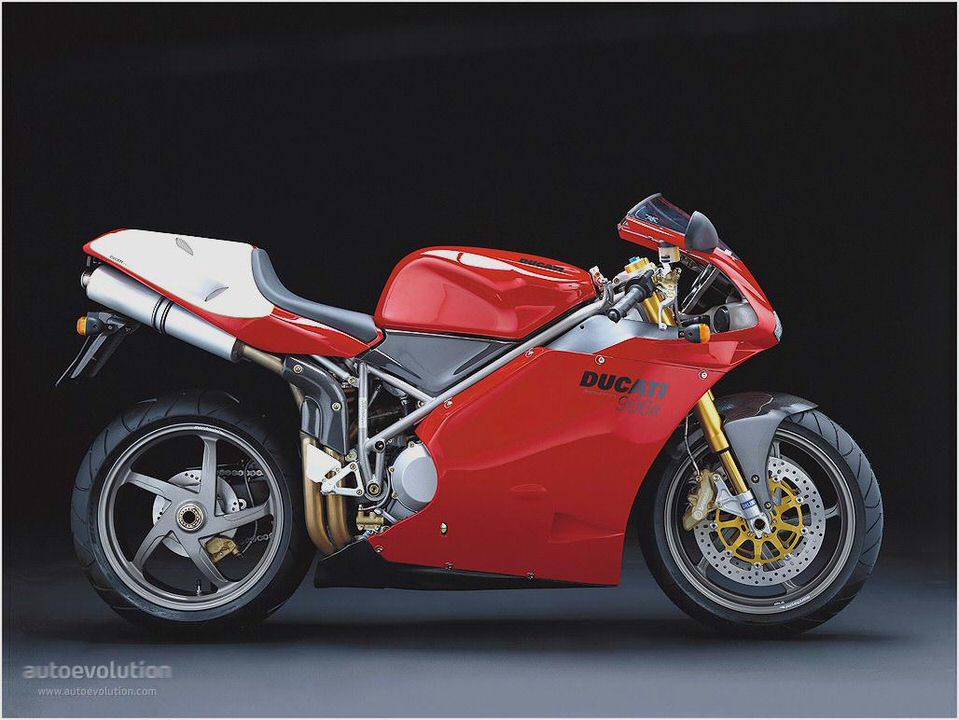
Contents
Versions
From 1999, there were three different models of the 996: a base, or Biposto; the 996S with Öhlins suspension and the engine of the 996SPS and finally the 996R which was the top-of-the line in the 996 range which featured the new 998 cc Testastretta engine.
Improvements
The 996 had larger 98 mm (3.8in) pistons, larger valves, a stronger crankshaft and crankcases ported from the 916 SPS. But since the 916 camshaft gave a softer, less peaky power delivery and less top-end power: 83.5 kW (112 bhp) as against the SPS’s 92.4 kW (124 bhp) the 996 was built with a new air intake system with two fuel injectors per cylinder. A new airbox and a distinctive underseat exhaust system were also built into the new design.
The bike
The chassis was also modified but in a much more discreet way – the 916’s handling was already well-regarded. Lighter wheels were introduced along with improved calipers, discs and pads stronger compared to the 916. The suspension system was still the same Showa design but both the front and back were fully adjustable for damping and preload.
Updates
Updates in 2000 saw the wheels change and get updated to all new Marchesini wheels. The front forks were also titanium nitrided to reduce stiction. The spokes also changed from the three-spoke rim style of the 916 to a new five-spoke scheme.
In 2001 another overhaul saw the 996 rear shock finally change from a Showa to an Öhlins increasing the 996’s capability even more.
The 996 SPS
The 996SPS suffix stood for ‘Sport Production Special’. The engine was the same as the one used in the 916SPS but the weight was cut down considerably. The 996SPS produced around 92.4 kW (124 bhp), more than the standard 996.
The 996’s special SPS engine was much stronger than anything that Ducati or any other manufacturer at the time had produced for the track. To ensure a distance was held between the standard 996 and the 996SPS Ducati designed a much higher specification chassis for the SPS. The wheels were a five spoke design but were lighter than the standard three spoke design of the 916 and the early 996.

In 1999 the rear shocks were made by high quality Swedish suspensions manufacturer, Öhlins with Showa front forks. In 2000 Öhlins forks were added. The adjustable steering head also allowed geometry changes to the steel tube trellis frame making it suitable for different riding styles or race tracks.
Top of the range: the 996 R
In 2001 Ducati introduced the limited production (only 500 were built), 996 R, the suffix standing for ‘Racing’, which featured Öhlins suspension (rear and front), carbon fiber bodywork, a revised and more streamlined fairing, but most importantly the newly redesigned engine, the Testastretta (narrow-head) which actually displaced 998cc. The engine got its name from the narrower angle between the intake and exhaust valves, down to only 25 degrees, which was designed by Ing.
Marchetti, coming from Ferrari F1. It featured more aggressive camshafts, titanium conrods and a shorter stroke and wider bore, which allowed it to rev more safely at high RPMs. It produced 98.5 kW (135 bhp) at 10,200 RPM with a maximum torque of 105 Nm at 8000 RPM.
Most of the chassis was the same as the 996 SPS, but using a new Brembo braking system, with thinner discs and 4-pad, 4-pot calipers with 34mm pistons.
Final updates
As the 996SPS and 996R became a hot commodity, Ducati updated the bike with more advanced chassis parts to make it stay competitive. Most notably the Öhlins front forks featured a titanium nitride coating on the stanchions to minimise stiction. An aluminum rear subframe and other detail modifications reduced the bikes weight even further.
- Lexus GS 350 Review – Research New & Used Lexus GS 350 Models Edmunds
- KarstenFilsoe.dk – Ducati ST2 review
- Mototrans Ducati 250cc 24 Horas – Part 1 – Classic Motorcycle Test – RealClassi…
- Ducati crankshaft lightening and balancing
- 2008 Ducati 1098 R

